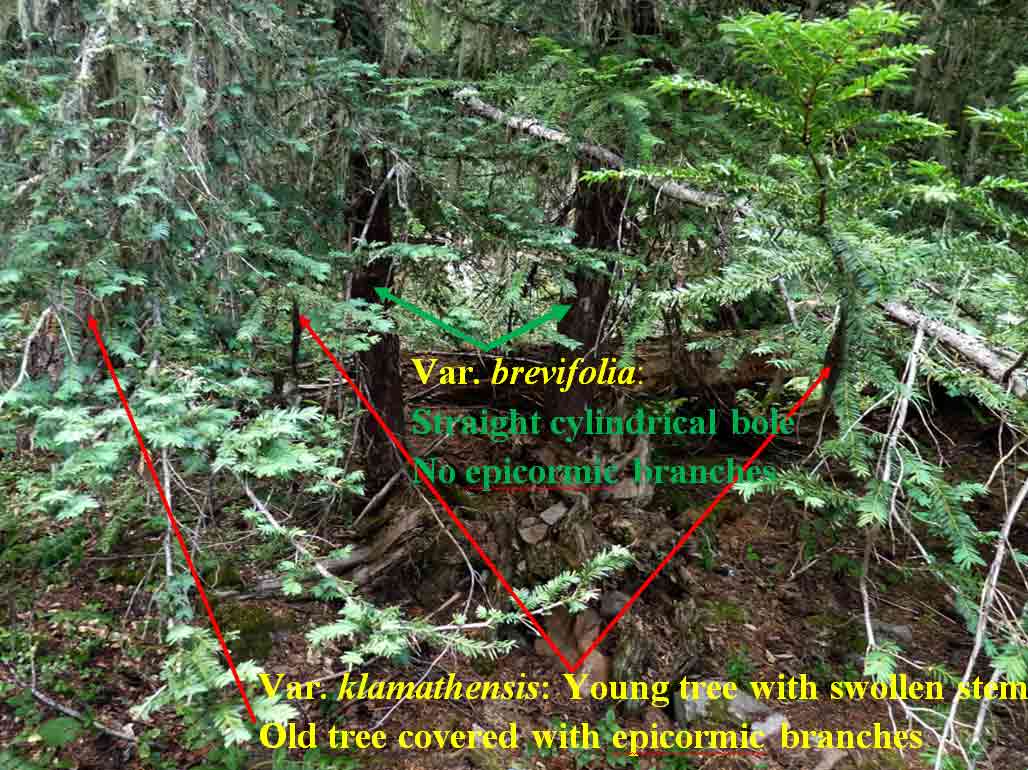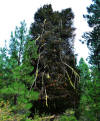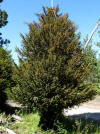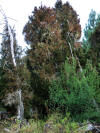 | |
3b. Taxus brevifolia Nuttall. var. klamathensis Spjut ineditus. Klamath yew. Trees, primarily distinguished by the abundant epicormic shoots on boles to the extent that boles are not visible on trees growing in open areas. Other distinguishing features include obese boles that are often swollen, arched or bent near base, and swollen branches; a topiary (self-pruning) appearance undoubtedly related to regeneration for trees in open areas as result of logging and possibly fire; leaves radial to somewhat decussate on the exposed epicormic shoots; pollen shoots developing during the summer abundantly near tips of branchlets as well as below, continuing to shed pollen late in the season (Aug 20 or later); orange to occasional yellow aril with the seed nipple partly exposed. Known from only the type location at the eastern boundary of the Klamath Mountains (Aug 2, 2011, Aug 18–20, 2014) bordering the southwestern part of the Cascade Ranges. The columnar to conical habit of the Klamath yew is similar to that of the Irish yew (T. fastigiata), Fig. 1, 2. They apparently have adapted to growing in open areas as evidenced by their dark green foliage and by their self pruning (topiary) appearance. However, the uncommon growth form in the Pacific yew is undoubtedly the result of trees left standing from select and clear-cut logging as seen by the persistent longer and recurved snag (dead) branches (Fig. 1, 2). Deer browsing may explain reduced growth or absence of branches near base of some trees (Bolsinger & Jarmillo 1990); however, epicormic branches were observed on boles where bark had not been removed, in contrast to lack of branches on boles where bark had been partially or entirely removed. It also appears that the old foliage—along with the branches—die, at least in some trees, after left in the open from clear-cutting (Fig. 9). The new growth that follows may not always be immediate as evidenced by dark green shoots growing out of old dead wood lying about in open areas. Nevertheless, charred stumps of Douglas fir and slightly burnt boles of yew were observed; however, the presence of scattered mature trees of Douglas fir and white fir also indicate burning was controlled or limited to slash. Although Pacific yew is usually killed by fire (Busing st al. 1995; Crawford 1983), it is known to regenerate from burnt stumps in the Klamath Mountains of Oregon (Bolsinger & Jarmillo 1990). In contrast to the Klamath yew, trees of the typical variety (var. brevifolia) that were also observed to have been left standing in logged areas do not show the dense growth of epicormic shoots on trunks; instead, they are more densely branched, which may be compared with trees growing in the nearby forest understory (Fig. 14). Their foliage often appears yellow to yellowish orange, or yellow green, not dark green as in var. klamathensis. Leaves of var. klamathensis initially show a bright yellow to orange on petioles before the blades turn yellow to orange. They soon drop, leaving yellowish orange twigs in contrast to the younger dark green foliage. Bark on branches is usually gray, and pink to red maroon on trunks. Leaves and buds near tips of branchlets often appear to dry blood red (possibly from drought), which would indicate a slight chemical difference in this variety, in contrast to var. brevifolia. All stages of survival and regeneration from standing trees and from adventitious shoots (from roots) of the Klamath yew were evident in the general area of the type location judging from size and developmental patterns of growth. Epicormic growth includes sequential and cauliferous shoots (Meier et al. 2012). The latter may also be termed adventitious in var. klamathensis since these shoots appear to originate from bark; however, because of their regular development on boles they are also regarded epicormic and are further differentiated as cauliferous shoots (Meier et al. 2012) if appearing adventitious on boles in contrast to the sequential shoots that are the long recurved branches. Adventitious shoots (Del Tredici 2001) are also recognized to develop from roots and stump sprouts; the different shoots in Taxus are viewed either as a regular developmental pattern for epicormic growth on bole in var. klamathensis or an irregular development of adventitious shoots on trunks, stumps and roots in var. brevifolia. If trees of Klamath yew in the logged areas are indication of what has survived, then one may conclude that Klamath yew is often found in open canopy forests. This is evident by secondary growth of wax currant (Ribes cereum), tan oak (Notholithocarpus densiflorus), service berry (Amelanchier alnifolia), snowberry (Symphoricarpos albus), manzanita (Arctostaphylos patula), buckwheats (Eriogonum spp.), and various grasses among scattered partially buried boulders, and by the presence of many young pines in which their presence seems to have been from intentional planting or seeding. One does not normally associate Pacific yew with this type of vegetation, while it is not clear if logging had removed more pine than fir since mature pines were rare; among the mature pines present, ponderosa pine was common, while Jeffrey pine was observed at only one site. The cauliferous shoots of Taxus brevifolia var. klamathensis that obviously proliferate upon sudden exposure to light—from logging—appear to grow on average up to 1 m in length on columnar trees, or up to 2 m in length on conical trees. Among the longer epicormic shoots of var. klamathensis are much shorter cauliferous branchlets, mostly simple, occasionally branched, <30 cm long. Numerous dead cauliferous branchlets persist among the live shoots (Fig. 2). In the shaded understory of the undisturbed forest of Douglas fir and white fir, the epicormic development resembles tufts of moss in depressed areas on the bole (Fig. 11). This would seem to correspond to dormant buds. As a general rule, if one can see the bark on branches and tree trunks, then it is probably var. brevifolia, not var. klamathensis except for the regular appearance of epicormic buds as just mentioned. The radial to somewhat decussate leaf arrangement is characteristic of epicormic shoots in plants that grow in open areas whereas in the understory trees they appear nearly two-ranked. Although the foliage is most often dark green, it varies in color from a frequent blue green to an occasional yellow green, which all were observed on plants growing side by side (Fig. 8). Several miles from the type location is a mature Douglas fir forest with a dense understory of Taxus at 6,000 ft elevation (1,829 m) that had mostly var. brevifolia (Fig. 14, 16). Yew trees observed at forest margins in logged areas were more openly branched with greenish yellow leaves (Fig. 14, 16). Within the vicinity of the type locality, it appears that both var. brevifolia and klamathensis come together as shown in the heading above; var. brevifolia appears more often in the understory of Douglas fir, and var. klamathensis evidently occurs with greater frequency in the understory of white fir and probably ponderosa pine. Nevertheless, both T. brevifolia var. brevifolia and var. klamathensis, and a third, var. reptaneta, exhibit affinity of mutualism or commensalism with Douglas fir by the frequent physical contact between them as shown below in several images (Fig. 12, 15). Under the page for var. reptaneta, ramets of one genet all were found growing more against Douglas fir instead of in the barren understory. A symbiotic type relationship is further inferred by the statistic of 89% of the forest stands with yew in western Oregon included the presence of Douglas fir (Bolsinger & Jarmillo 1990). Taxus brevifolia var. polychaeta has been found growing with the California nutmeg, Torreya californica, at several sites in Sonoma County, California, and a similar association also is known for the Florida yew and Florida nutmeg (Spjut 2007a). It is also occurs within the redwood forest. Many plants of Klamath yew were observed to have swollen boles near base, and/or on branches and twigs. This may be due to endophytes as often seen in species of Ephedra; however, where the stems are not swollen they are generally about twice as thick as those of var. brevifolia (Fig. 12, 15). Bolsinger and Jarmillo (1990) give data on age of plants based on diameter of stems 15 cm above base; a tree having a diameter of one needle in length (2–3 cm) would normally be expected to have an age of 25 years. In one of the images shown below (Fig. 5), a tree about 50 cm high appears to have a bole 10.5 cm high and 3 cm diam. based on needles near base. Needles of Klamath yew have been measured in specimens to average 1.3 cm in length. These can be used to gage the diameter of boles. Bolsinger and Jarmillo (1990) indicated that Pacific yew left standing in the open cut area increased their diam. by 0.18 cm per year based on measurement taken after 12 years of growth, but data on change in height was not reported. Bailey and Liegel (1997) also reported increase in bole diameter 0.47 mm/yr for trees left standing without canopy after logging based on a 10 yr interval. Assuming that the Klamath trees were left standing 12 years ago (1989), an increase of only 2.5 cm might be expected. It would seem that bole obesity in var. klamathensis is greater. Male strobili develop in successive leaves near ends of branchlets as also the ovuliferous shoots on separate plants (dioecious). They also develop at ends of leafy branchlets but the growth of the leafy shoot is probably suppressed until perhaps the next season. The microsporophylls apparently continue to emerge during a season and release pollen later than in the other varieties based in part on a study by DiFazio (1995) that showed data for duration of pollen shedding for 42 trees at four sites in the western Cascades and Coast Ranges of Oregon, ranging in elevation from 200–1200 m; the trees had shed their pollen by the end of April. The above photos for var. klamathensis were taken August 2 (2011) and Aug 20 at three sites within a 9 sq mile area ranging in elevation from 4,700–4,800 ft (1,432–1,463 m). Immature seeds are somewhat ellipsoid, less ovoid as generally seen in the species. Arils were only seen sporadically on Aug 20 (2014). Most were orange; on one plant they were yellow. Their sporadic development may be due to the drought (2011–2014-) or they may mature over a longer period as indicated for the pollen shoots. The features described for Taxus brevifolia var. klamathensis may suggest that it should be treated as a distinct species; however, leaf epidermal features have been given more weight to differentiating species of Taxus in the Wallichiana Group (Spjut 2007a, 2007b). In T. brevifolia these include the tall rectangular leaf epidermal cells as seen in x-section, 4–7 stomata rows per band, and distribution of papillae across the abaxial leaf surface, all agree with T. brevifolia. Taxus globosa differs by having more stomata rows per band (9–11), and var. floridana overlaps in the northernmost range of var. globosa in Mexico in having 7 stomata rows per band. The geographical range of the Klamath yew is based partly on field knowledge gained over many years of travel in the western U.S. It was not until interest in taxol developed that I recall seeing yew trees left standing in U.S. National Forests. Photographs of such trees are shown under var. brevifolia for years 1987, 1989, 1997, and 2010. The photos were taken during the late 1980's when I traveled across the United States and British Columbia in recollecting lichens for cancer research, and during 2007–2011, when I traveled more than 200,000 km in survey of Veratrum californicum in the western United States for cancer research. It was not until Aug 2011, that I encountered the proposed new var. klamathensis. Details of the exact locations are not revealed to protect the plants from yew collectors. Logging operations occur presently in the region, but the practice of leaving the trees standing seems only to change their appearance. Whether this is a temporary form cannot be determined, perhaps for another 100 years. It is also likely that the Klamath yew will be found elsewhere.
3b. Taxus brevifolia var. brevifolia 3c. Taxus brevifolia var. polychaeta 3d. Taxus brevifolia var. reptaneta
|




































